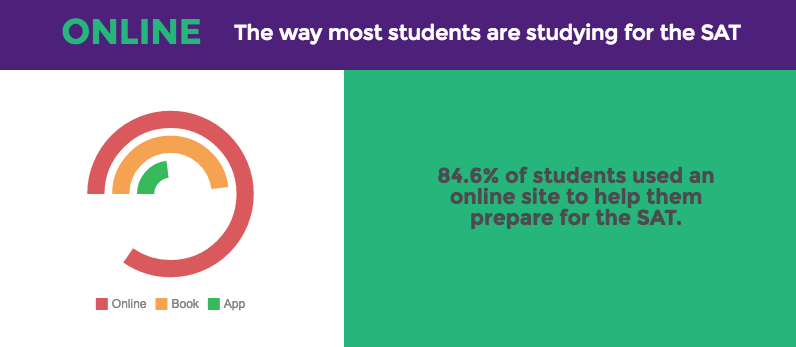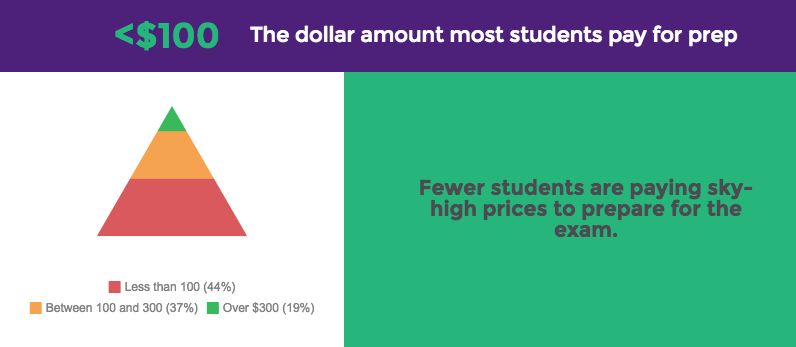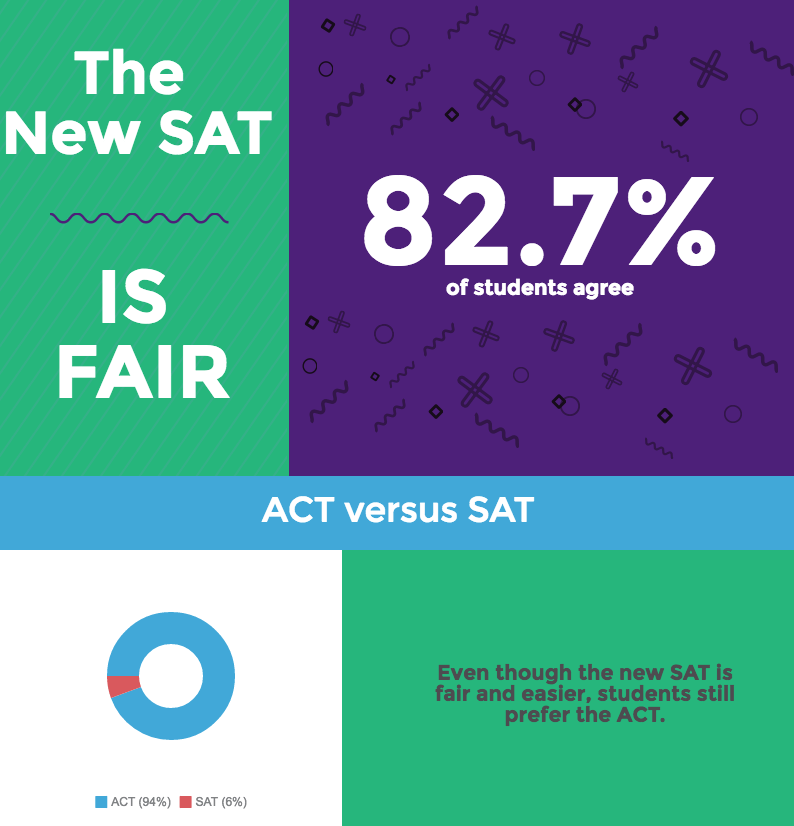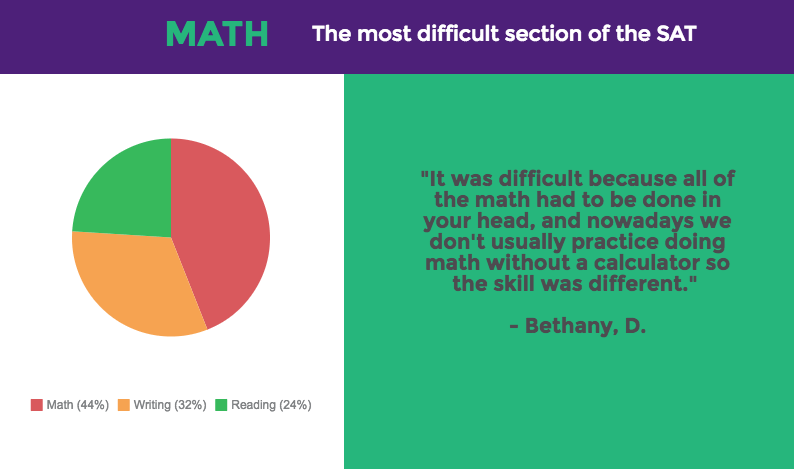In the midst of much public discussion about changes to the SAT and speculation about the exam and its impact on students, our high school team decided to run a survey to find out how students reacted to the new SAT. We also sought to answer a larger question: What does the redesigned SAT mean for students in the evolving ecosystem of assessment and evaluation of college readiness?
The goals for the survey were: 1) to get feedback on our new SAT prep product so we know how to improve it; and 2) to give us insight into the exam so we can alleviate concerns for our students. This report covers our findings from the survey and advice for how to prepare for the new SAT.

Keep scrolling to read the full article or jump right to the sections you’d like to learn more about!
- High school studies are largely aligned with and are meeting the demands of the test with the exception of math; the way students are taught math in school is not adequately preparing them for the exam.
- Test prep is becoming more about what you’ve learned in school and less about gaming the test. In this article, we recommend some every-day habits that can help you prepare for the new mental challenges of the redesigned SAT.
- Technology is changing the way students prepare for standardized tests, and it is putting more of the responsibility on students.
Overview of Findings
How we got input from students
We initially shared the survey with students who had used Magoosh to prepare for the SAT. Later, we realized that surveying a broader population who had used a wide range of test prep services would give us better insights into all the factors affecting students.
We asked students through our Magoosh High School Blog if they would be interested in participating in this study and received a torrent of positive responses.
From the interested group, we emailed a diverse group of students who were taking the first redesigned exam on Saturday, March 5, 2016. Some of these students had used our online SAT prep program, our trial, or one of our mobile apps to study and others had just heard of Magoosh because of our internet appeal for participants in the study.
The students who participated in the survey were high school sophomores, juniors and seniors from California, New Jersey, New York, Pennsylvania, Georgia, Minnesota, Colorado, Alabama, Ohio, South Carolina and Indiana. Following are the detailed findings from the more than 100 students who participated in this study.
Detailed findings from the survey
Finding 1: Students are tossing aside books for the web, but haven’t gone mobile yet.

- Did you use any online sites to prepare?
- 84.6% “Yes”
- 15.4% “No”
- 51.9% “No”
- 48.1% “Yes”
- 76.9% “No”
- 23.1% “Yes”
Did you use a book to prepare?
Did you use any apps to prepare?
Admittedly, the students who completed our survey were already predisposed to studying online. However, with the nod toward online prep that the College Board gave by teaming up with Khan Academy, we are seeing more and more students turn to the web to study. Students are not only using free and paid practice products, but are also on YouTube and blogs looking for answers. At Magoosh, we have seen significant spikes in our online traffic in the days leading up to an exam. The traffic to our YouTube videos usually increases by 160% and readership of our blogs increases by 80%.
As for books, while we do advocate for using the official College Board “blue book”, there is currently no reason for students to purchase the Official SAT Study Guide 2016 as a book, since the tests and answers are all available online for free on the College Board website or Khan Academy. In fact, we don’t think any student should spend money on a new SAT book until the College Board release another batch of exams.
The small percent of students who use apps to study is surprising, until you do a search in the app store(s) for SAT prep. It is saturated with low quality apps. Furthermore, many SAT apps — and Magoosh is guilty here as well — still focus on studying vocabulary, which is no longer a main focus and fear for those studying for the SAT.
Finding 2: The cost of studying is dropping, but there is still a premium on quality content.

- How much did you pay, in total, for your prep?
- 44.2% “Less than $100”
- 36.5% “Between $100-300”
- 19.2% “More than $300”
There are more free or inexpensive resources available for SAT preparation. 44% of students are spending less than $100 total to study, which is a dramatic shift considering that there are few test prep options that are in this price range (Magoosh being one). However, there is a significant segment of students who pay for test prep, which may indicate that students (and their parents) still see value in additional support beyond free practice tests and questions. This higher value support may include advice on test-specific strategy, personal attention from a tutor, lessons on content, and more thorough explanations of correct and incorrect answers from the College Board’s perspective.
Finding 3: The new SAT is a fair and easier, but still not a winner.

- Did you use knowledge from high school or from test prep?
- 40.4% “50% high school and 50% test prep”
- 34.6% “Majority high school”
- 25% “Majority test prep”
- 82.7% “Yes”
- 17.3% “No”
- 66.7% “Easier”
- 33.3% “Harder”
- 94.4% “ACT”
- 5.6% “SAT”
Do you think that the exam was a fair evaluation of your knowledge and readiness for college?
(For those who had taken the old SAT previously) Did you find the new SAT easier or harder?
(For those who had taken the ACT as well) Would you recommend the ACT or SAT?
The new SAT is a vastly different test than the old SAT. In the past, students and adults alike have contended that the SAT was designed to trick students and tested skills and knowledge that they didn’t learn in school. The new SAT gets away from its sordid past by aligning itself with the Common Core, and therefore with what students are learning, or are supposed to learn, in high school. It succeeds in this way but with one major flaw: Most students still prefer the ACT.
At the same time, the ACT is far from a perfect assessment of student knowledge and preparedness for college. Standardized tests are just one data point that colleges and universities have to assess a student’s ability to succeed in a specific academic environment. Most schools do not rely exclusively on test scores to make their decision, rather they look at a variety of factors from a student’s involvement in the community, learning trajectory and improvement over time, to their personal passions and interests. At the end of the day, they want their college campuses to be thriving places of ideas and interesting individuals, and not just full of people who had perfect test scores.
Finding 4: It turns out Reading and Writing are not the most challenging sections of the new SAT. Math is.

- What did you think was the most difficult section of the new SAT?
- 44% “Math”
- 32% “Writing”
- 24% “Reading”
After so much media speculation (eg. New, Reading-Heavy SAT Has Students Worried) about the difficulties students would have with the Reading and Writing section of the new SAT, students have finally spoken: It is actually the math section that was the most challenging. Those who did find the Writing and Reading sections to be difficult cited the challenge of finishing within the time limits. The math section caught more students off-guard with its wider range of question types and proved challenging for many who were not used to completing math without a calculator.
Top tips for taking the new SAT from students who have already taken it

As a test prep company, we are in the business of giving advice to students about how and what to study. Still, some of the best advice comes from students themselves:
- 35.9% recommended continuous, daily practice
- 23.1% recommended practicing mental math specifically
- 12.8% recommended reading and writing more in your day to day life
- 10.3% recommended being more aware of timing and practicing with time limits in mind
And, in the words of one student: “Study study study! The more confident you are in the material, the more you have a chance at succeeding. Guessing can only go so far.”
Everyday tips for new SAT prep
The redesigned SAT is a much more prepable test; you can do well on it without spending large sums of money or memorizing tricks and words you won’t ever use again. A lot of the ways that you can prepare are also good life-habits; getting good at critical reading and mental math will serve you well in the long run. Here are our top three ways you can start preparing for the new SAT in your day-to-day.
Tip #1: Read more. The new SAT reading section includes a passage from classic or contemporary literature, a passage from or about a U.S founding document, a section about a social science topic and two science passages. This is a very wide range of topics so you will benefit from reading a diverse caste of articles at a fairly sophisticated level. We recommend getting in the habit of going to The Atlantic Magazine online everyday and choosing a few articles to read that resonate with you. If you are ready to kick it up a notch, you can invest $10 in The Best American Science and Nature Writing and practice reading science topics. Most importantly, it isn’t enough to skim passages. You need to start digesting what you are reading thoroughly and critically. Discuss what you have read with your friends and family. Reflect on the author’s meaning and main points. This level of analysis will help you answer questions with ease on the Reading and Writing sections of the new SAT.
Tip #2: Write more. On the SAT you will have 50 minutes to complete the optional essay. With a few minutes of thinking, outlining and editing, that leaves about 35 minutes of writing by hand. For those of you accustomed to typing nearly everything, that may leave your hand cramped and make the essay more of a physical struggle than you may have envisioned. Fortunately, the remedy for this is simple: Write by hand more often. You can journal about your day, your thoughts about what you have read (above) or any topic that you can write passionately about for 30+ minutes. Once your hand muscles are up for the challenge, you can turn your attention to how to craft a compelling essay.
Tip #3: Put away the calculator. Getting good at mental math is simply a matter of learning (or relearning) some simple building blocks. Next time you see a number, think about its multiples and what it is divisible by. Learning multiples by counting (13, 26, 39, 52, 65, etc.) helps your brain add quickly and also helps you notice these numbers (“hey look, it’s 65–it’s divisible by 13”). Try to integrate mental math into your everyday: Calculate your average grade on math quizzes without using your calculator. If you’re splitting a pizza between friends, do the division in your head. Whenever you find yourself reaching for your phone or calculator to do a simple calculation, stop, and do it in your head instead. Developing this level of familiarity and comfort with numbers will alleviate some of the stress and foreignness of doing mental math on the test.
How to study online for the new SAT
We think the redesigned SAT is a step in the right direction. It is a more accessible test, the partnership with Khan Academy has made preparation for it more affordable and it is more aligned with what will suit student in the long term. And while some may see this most recent SAT redesign as just another shift by the College Board to position the SAT in a market battle against the ACT, we see this change as a marker of something more.
This is the first year that online preparation for the SAT has gone mainstream and the ACT is not far behind. While test prep companies continue to put out books, offer classes and tutors, we think that more students will be turning to the web for answers. While this can be a great benefit to students, we caution that not all online learning tools are created equally. So think critically about what you will use to study. Is it rigorous? Thorough? Does it help you evaluate your strengths and weaknesses? Test prep expert Kristin Fraccia has written a great post on How to Choose Online Test Prep for the SAT or ACT
Finally, though online options make test prep accessible, they also place more responsibility on students. With online test prep, it is not enough to sit passively in a class or rely on the guidance of a tutor. Students must dedicate time and energy to their studies, which makes them more accountable to themselves. That may be the biggest life-lesson students will learn by studying for the SAT.

